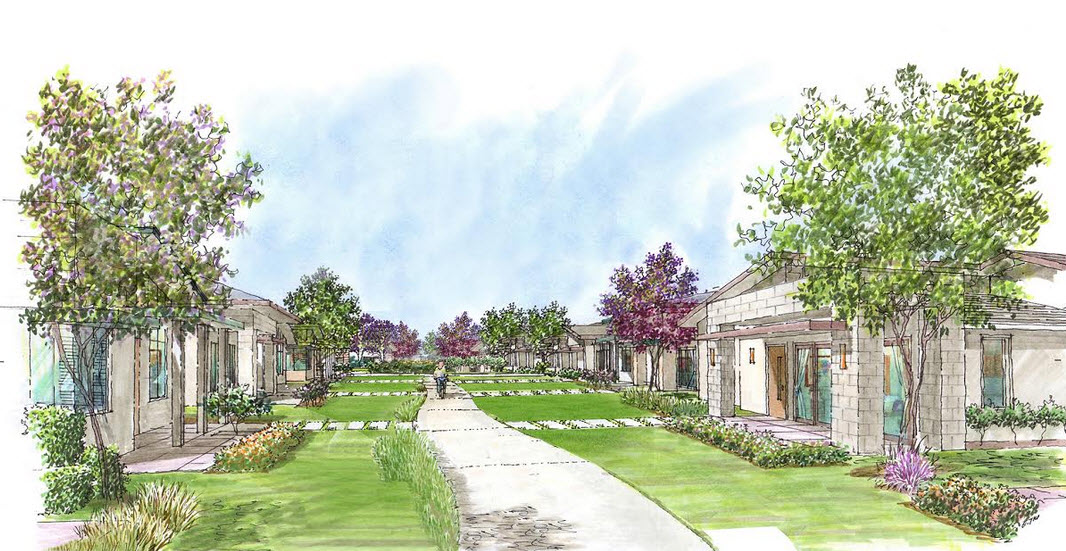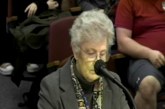
Active adults want to downsize but options are few
(Sponsored article – paid for by West Davis Active Adult Community) – The news is a familiar story: People who work in Davis want to live and retire here, often with their extended family.
As of July 26, the median price of a single-family home in Davis is $636,000, according to Zillow. That price has gone up 9.9 percent in the last year, and is forecast to increase another 5 percent in the year ahead. Fewer than 100 homes were listed for sale. Of those, 44 fell at or below the median price.
This housing shortage continues to drive the price out of reach for UC Davis faculty, staff and other local employees, said Dave Taormino, a longtime Davis real estate developer and proponent of the West Davis Active Adult Community. Besides the obvious frustration among prospective home buyers, there’s a ripple effect on the school system.
Taormino’s new proposal for active adults and seniors offers a creative approach to ease that burden. He explains it like this: Approximately two-thirds of Davis resale homes are being purchased by families with young children. Meanwhile, many empty nesters have larger, under-utilized homes. But in Davis, there are few alternatives for older residents to downsize into single-story homes. Offering options for active adults, and helping them stay in town — in a traditional neighborhood and lifestyle — would free up those larger homes for families with children, he argues.
“About 5,000 homes are owned by residents age 50 or older. Offering ‘right-sized’ housing to active adults will help counter the dropping enrollment in the Davis Joint Unified School District,” he said. The district was forced to open spots for some 650 transfer students from outside the area last school year to fill in the vacancies. “Those families receive the benefit of Davis schools without paying the extra taxes and housing costs Davis residents do. At some point that is likely to be of concern to Davis residents.”
According to a July 11 report by the Sacramento Area Council of Governments, the Sacramento region is not keeping up with demand for housing, based on population growth. More immediately, UC Davis expects an additional 7,000 students over the next seven years, with most students housed on campus. Its Long-Range Development Plan anticipates an additional 2,500 faculty and staff members, many of whom will have school-age children. Local businesses need housing for their employees, and aging Davis residents need options.
“Good community planning should be thoughtful and focused,” Taormino said. “Focusing on people first, instead of just looking at a piece of land and asking, ‘How many houses, if any at all, can we fit here?’”
That’s how Taormino’s team approached the West Davis Active Adult neighborhood plan. The neighborhood is designed specifically for Davis’ older residents. It features 325 small to medium single-story homes ranging from 900 to 1,800 square feet, along with 150 affordable senior apartments. Eighty percent of the homes and all the apartments will be restricted to residents 55 and older. The remaining 20 percent will be attractive to families because of the homes’ sizes, he said. Since the project is on the city’s periphery — at Shasta Drive and West Covell Boulevard — it would go before Davis voters, likely in June 2018, if approved by the Davis City Council.
For active adults, especially those who have lived in the same home for decades, the transition to appropriate housing can feel overwhelming. To encourage the process, Taormino is developing a program with the Davis real estate community that would help older residents make the move seamless.
It all circles back to providing housing that meets Davis’ internal needs. “Imagine a Davis with a dwindling number of UC Davis faculty and staff living here,” Taormino said. “What’s going to happen to the character of our community as the prices continue to escalate, coupled with builders’ interest in constructing larger and more expensive homes as we see at The Cannery?”
He continued, “Davis, for the 50 years I’ve been here, has pride in being a family-oriented, inclusive community. This includes an active older population, which has increased significantly. As a group, they need more consideration, especially in housing size, design and choices.”
West Davis Active Adult Community is sponsoring this section on the Vanguard because we believe providing more information is better.
Previous articles:





“Davis, for the 50 years I’ve been here, has pride in being a family-oriented, inclusive community”
So therefore the developer wants to build exclusionary, discriminatory housing where families are banned. I must be missing something.
I don’t believe families are banned, there is a percentage of the proposal that would be market rate and non-exclusionary.
“It features 325 small to medium single-story homes, and affordable senior apartments. About 80 percent of the homes would be restricted to residents 55 and older. ”
So. That means about 65 homes would be available to family – for whatever that’s worth. Not judging.
It seems an odd, if not completely cynical, phrasing.
Some portion of whom will be able to exclude themselves from paying school parcel taxes by virtue of their age. Trying to sell this project as being beneficial to the schools is questionable at best.
And they have raised this issue for every Measure J/ R project and the voters are not moved by it, so why continue to raise it? The voters will vote for a parcel tax for schools, not a development project
Interesting insight, David… people (anyone over 65) know they can vote for the DJUSD parcel taxes, and not have to put their money where their votes are…
Some will not take their exemption… some will…
Primarily because of the “it’s for the kids” rhetoric, not looking at the same metrics that you espouse on City taxes (reduction of or caps on upper management salaries, ‘right-sizing’ as to personnel, particularly in Admin, the ‘union’ requirement for teachers, I’ll take the exemption, just out of spite. ~ 2.5 years from now…
BTW, the ‘senior exemption’ was a somewhat cynical way to pass the taxes… exempt the voter group most likely to vote…
I’m failing to follow the authors’ logic. So, the idea is that empty-nesters can downsize from their 2800 sq ft home and then young families can buy the empty nesters’ home, thus solving the housing crisis and saving the Davis schools. This would indeed be great but how many young families can afford a large $750,000 home? Young families usually have lower incomes and high childcare costs. And then there’s college and retirement savings. It seems like what young families need is affordable housing, not big houses on big lots that they can’t afford.
I do like the idea though of enticing older adults to sell their homes because it would trigger a property tax reassessment. I think for that reason alone, I’d vote for the West Davis Active Adult Community.
They will market to people everywhere, “come to Davis where it is safe”. There is no reason to think that the people who move in will be from Davis.
A result that is just as likely is that they keep the old house and rent it out or allow their grown children to live in it, thus preventing any property tax reassessment or increase in housing availability.
With school funding coming from the state anyway the assessment of the house makes no difference. The only way we could get a fair amount of funding would be if Dodd and Curry were more interested in their constituencies than their political futures but chances of that are remote.
Every argument here loses to the ridiculous proposal to increase automobile and even transit dependence for people as they age. As cycling modal share targets – if any – for 50+ people are not being met, training people to use buses – as the city wisely does – should not be an enabler for moving them to the periphery. The ability to cycle under ideal conditions, drive safely and take transit that works for one’s schedule is one thing at 50 to 65 or 70, but another after that: Forgive me if I am mistaken, but aren’t these homes meant to be last ones these folks will purchase? Under current outdated development law in Davis that’s been left in the dustbin of other cities in California, the EIR for this place will clarify an acceptance of traffic congestion but not how to fight congestive heart failure. Does Davis have a walking modal share goal for seniors? (Visual: Davis voters laughing at watercolor-visualization of seniors on bicycles in the Davis Enterprise along with a photo of Dave Taormino shaking hands with an “empty nester”, the former with fingers crossed behind his back.)
Todd, much of the solution is to encourage dispersed commercial development in the neighborhoods so people can more easily walk/bike to stores. We can see that model working very successfully in older, larger coastal cities. We need to change the zoning in the existing neighborhoods. Then whether this development is on the periphery will no longer matter.
Is this being considered in this project? Would anyone considering a store put it in a neighborhood of dispersed houses? This isn’t a dense city. I don’t think this comment makes any economic sense
No, people in this subdivision will shop at the Marketplace center anchored by Safeway, just as people in The Cannery will shop at the marketplace anchored by Nugget. I often wonder what kinds of quaint little shops people think are going to open in little neighborhoods, where there would be insufficient traffic to sustain anything other than a tiny little convenience store at best. The only stores that might open would have to be regional draws, which would require larger square footage than the zoning allows and would violate fundamental planning principles in our current General Plan. The Cannery developers promptly tried to go in that direction once construction was underway. These neighborhood aren’t big enough to sustain their own neighborhood shops. That’s what the existing centers are for. Anything bigger than that is a whole different traffic paradigm than what they put forth in the plans that go through the EIR etc. So it ends up either creating non-viable retail (we have examples already…) or amounting to a form of bait-and-switch.
I seem to recall there was going to be a retail component to Village Homes based on this sort of urban planning fantasy. They did get a great restaurant out of it, at least, but I bet he’d like a bigger location somewhere.
Don, smaller retail, including walk up small groceries can be viable in neighborhoods in Davis. Also smaller restaurants that don’t have to pay the higher downtown rents. Various personal services also can work. Just travel around most Bay Area cities or Los Angeles, and you can see how this works. Trying to force everything into the larger shopping areas appears to be the recipe for nonviable small businesses. Look at the problems in the centers at East 8th and Lake.
Prop 13 is much to blame for seniors living for too long in houses too large. I calculated a few years ago that the need to buy out the property tax benefit from an existing homeowner added at least 15% to the price of a house.
In a world where the real estate market actually functions, affordable housing is yesterday’s new development as wealthier homeowners move to newer housing. That can’t happen now, so we’ve created a mess with a bunch of inadequate proposed solutions.
Not getting this, please explain.
If a homeowner is currently paying $1000 a year on a tax assessment of $100,000 from 1980, and they now are looking at paying $5000 a year for a tax assessment to move to an equivalent $500,000 new house, that’s $4000 a year more. The net present value of $4000 on 4% interest is $100,000 or an additional 20% in expenses over the life of the mortgage. If instead, the tax assessment had been allowed to rise with housing prices as it does in most states, and was now $500,000, there would be no difference in old and new property tax.
I see where you’re coming from, but remember assessments from 1980 have been going 2% compounded a year as per Prop. 13.
On November 4, 1986, the voters of California passed Proposition 60 to provide to qualified homeowners the transfer of the base-year value of their principal residence to a replacement dwelling located in the same county, under certain circumstances.The requirements for this exclusion are as follows:
At the date of transfer of the original property, the transferor (seller) must be at least 55 years of age. (If married, only one spouse must be at least 55, but must reside in the residence; if co-owners, only one co-owner must be at least 55 and must reside in the residence.)
The replacement property must be purchased or newly constructed on or after November 5, 1986. The replacement residence must be purchased or newly constructed within two years before or after the sale of the original residence.
The sale of the original residence must qualify for reassessment as the result of its transfer.
The principal claimant must have been (1) receiving or eligible for a Homeowner’s Exemption or (2) have been receiving a Disable Veteran’s Exemption on the original and replacement residences.
The replacement residence must be “equal to or lesser” in market value than the original residence. In general, “equal or lesser” than market value of a replacement dwelling has been defined as: 100% of market value of original property as of its date of sale if a replacement dwelling is purchased before an original property is sold; 105% of market value of original property as of its date of sale if a replacement dwelling is purchased within one year after the sale of an original property; 110% of market value of original property as of its date of sale if a replacement dwelling is purchased within two years after the sale of an original property.
The claimant and/or claimant’s spouse can only be granted relief under this section once. The disclosure of social security numbers by all applicants is required. They are used by the assessor to verify the eligibility of persons claiming this exemption and by the state to prevent multiple claims in different counties. This claim is not open to public inspection.
Keith O, 2% a year only doubles the value since 1980. I’d love to have just gotten my new house in Central Davis for double its 1980 value!
Jim, two keys provisions here. 1) “The replacement residence must be “equal to or lesser” in market value than the original residence.” Older individuals often buy into higher value houses because they have so much equity. 2) The transfer can occur only once. People move on average every 7 years.
“sponsored article” – is that not an oxymoron?
I do appreciate that it is being acknowledged upfront, unlike earlier-advertisement articles that posed as journalistic pieces
“Taormino’s new proposal for active adults and seniors offers a creative approach to ease that burden. He explains it like this: Approximately two-thirds of Davis resale homes are being purchased by families with young children. Meanwhile, many empty nesters have larger, under-utilized homes. But in a Davis, there are few alternatives for older residents to downsize into single-story homes. Offering options for active adults, and helping them stay in town — in a traditional neighborhood and lifestyle — would free up those larger homes for families with children, he argues.
“About 5,000 homes are owned by residents age 50 or older. Offering ‘right-sized’ housing to active adults will help counter the dropping enrollment in the Davis Joint Unified School District,” he said. The district was forced to open spots for some 650 transfer students from outside the area last school year to fill in the vacancies. “Those families receive the benefit of Davis schools without paying the extra taxes and housing costs Davis residents do. At some point that is likely to be of concern to Davis residents.””
Some cognitive failures in this piece.
1: Reassessing Davis real estate will not affect the amount of revenue our schools get.
2: Having more locals and fewer transfers will not affect the school revenue. It will be a net detriment in some ways as we have to take locals but choose to take transfers so we will have less flexibility in ADA. We can reduce the number of transfer students without building a new development. Also some of the transfers are grandfathered in so by adding local students we will increase the total and we may not have space in elementary schools. NDE, Birch and Willett, at the least, are already overflowing certain grades.
3: There may be a small increase in parcel tax revenue depending on how many sales there are from seniors to younger people people and what percentage of those seniors filed for the exemption. Of course if this is the major concern we could just amend the current parcel tax to eliminate the senior exemption which would be more effective.
Why does this sponsored article remain at the top of the queue?
Because you have not paid to promote a different one…
So is “sponsored article” another way of saying paid advertisement?
“Sponsored article – paid for by West Davis Active Adult Community”
Yes, this is a paid advertisement
It threw me off because I can’t remember the Vanguard ever putting a paid advertisement in the “latest news” category.
First one.
I see it made the top of the “most popular” list too with only 31 comments.
Because it’s sponsored . . . the answer is in the question.
This is a REALLY BAD IDEA, IMHO. I went to the Vanguard page a couple of times this morning and thought the server was down as the top article was still yesterday’s, or that DG took a day off . . . nah, forget that second one.
It’s a better article than the lame one they put in The Enterprise about old people being volunteers and the foundation of the community.
Was that a paid advertisement too?
It does not say so but it attracted a number of negative comments which have been scrubbed.
http://www.davisenterprise.com/local-news/older-davis-residents-give-more-time-funds/
The comments were scrubbed? LAME!!! (if true)
There were comments and now there are no comments. However this could have occurred for a number of reasons unrelated to content.
I don’t understand how this will actually help more families be able to afford to live in Davis. Any housing development is good. But I don’t know how helping those who already have very valuable houses to get slightly less valuable houses is the solution to the housing crisis.
I was mostly neutral about this proposal. But I really hate having my intelligence insulted that these are “articles”. So I may vote against it just to discourage advertising campaigns like this. Actually my intelligence isn’t insulted, I’m just concerned about people who don’t have my intelligence and actually believe these are articles.
Older folks now own a larger proportion of homes, which is creating a barrier to entering the housing market for younger generations. See this from Bloomberg: https://www.bloomberg.com/news/articles/2017-08-08/baby-boomers-who-won-t-sell-are-dominating-the-housing-market?ex_cid=SigDig
“would free up those larger homes for families with children, he argues.”
Or may free up those homes for purchasers from out of area and able to pay cash, or for those who want to purchase and rent out to students by the room or bed. I am neither for nor against the project at this time. Just feel that the scenario may not be as rosy as being portrayed.
This thing is still lodged on top of the news column, like an unwanted splinter? The longer it stays there the more likely I am to vote against the project. How long is this staying on top, until the election? (whenever the F— that is).
Maybe it will stay there until the next “(Sponsored article – paid for by West Davis Active Adult Community)” is submitted and takes it’s place in the “latest news” and “most popular” categories.
Most popular my arse!